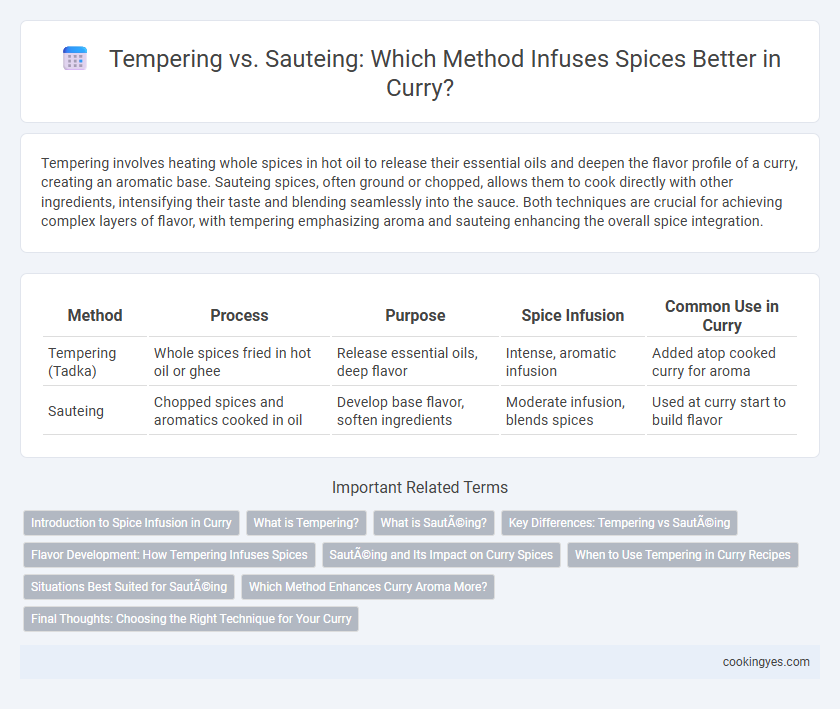Tempering involves heating whole spices in hot oil to release their essential oils and deepen the flavor profile of a curry, creating an aromatic base. Sauteing spices, often ground or chopped, allows them to cook directly with other ingredients, intensifying their taste and blending seamlessly into the sauce. Both techniques are crucial for achieving complex layers of flavor, with tempering emphasizing aroma and sauteing enhancing the overall spice integration.
Table of Comparison
| Method | Process | Purpose | Spice Infusion | Common Use in Curry |
|---|---|---|---|---|
| Tempering (Tadka) | Whole spices fried in hot oil or ghee | Release essential oils, deep flavor | Intense, aromatic infusion | Added atop cooked curry for aroma |
| Sauteing | Chopped spices and aromatics cooked in oil | Develop base flavor, soften ingredients | Moderate infusion, blends spices | Used at curry start to build flavor |
Introduction to Spice Infusion in Curry
Tempering and sauteing are two essential techniques for spice infusion in curry, each impacting flavor development differently. Tempering involves briefly heating whole spices in hot oil to release their aromatic oils before adding other ingredients, intensifying the curry's aroma and depth. Sauteing spices along with onions or garlic allows gradual flavor blending, creating a balanced and rich curry base.
What is Tempering?
Tempering, also known as "tadka," is a traditional Indian cooking technique where whole spices are briefly fried in hot oil or ghee to release their essential oils and deepen their flavor before being added to curry. This process enhances the aromatic complexity and intensifies the taste profile of the dish by infusing the oil with the spices' essences. Unlike sauteing, which cooks ingredients fully, tempering focuses on rapidly infusing oil to amplify spice flavors in curries.
What is Sautéing?
Sauteing in curry preparation involves cooking spices and ingredients quickly in a small amount of oil or ghee over medium-high heat to release their natural flavors without burning. This method enhances the aroma and taste by allowing spices like cumin, mustard seeds, and turmeric to infuse gently into the base ingredients. Sauteing ensures a balanced spice profile, crucial for achieving the rich, complex flavor typical of authentic curry dishes.
Key Differences: Tempering vs Sautéing
Tempering in curry involves briefly heating whole spices in hot oil to release their essential oils and aroma, creating a flavor base that infuses the dish subtly and evenly. Sauteing typically cooks chopped onions, garlic, or ground spices over moderate heat, enhancing their sweetness and depth while integrating spices more directly into the curry's texture. The key difference lies in tempering's rapid, high-heat method for spice essence extraction, whereas sauteing focuses on developing rich, caramelized flavors through prolonged cooking of ingredients.
Flavor Development: How Tempering Infuses Spices
Tempering, also known as tadka, involves heating whole spices in hot oil or ghee, which releases essential oils and intensifies their aroma, creating a deeper, more complex flavor profile in curry. Unlike sauteing, where spices and ingredients are cooked together, tempering allows spices to bloom separately, ensuring maximum extraction of their natural flavors. This technique enhances the curry's taste by infusing the oil that permeates the entire dish, resulting in a richer and more balanced spice infusion.
Sautéing and Its Impact on Curry Spices
Sauteing curry spices in oil at medium heat allows the natural flavors to bloom gradually, creating a deeper and more balanced taste profile. This method enhances the aromatic compounds by gently releasing essential oils, which blend seamlessly into the curry base. Compared to tempering, sauteing provides a more uniform spice infusion, intensifying the richness and complexity of the curry dish.
When to Use Tempering in Curry Recipes
Tempering is ideal for curry recipes that require infusing whole spices like mustard seeds, cumin, or fenugreek, as it extracts maximum flavor and aroma when these spices sizzle in hot oil at the beginning of cooking. Use tempering at the start of the recipe before adding other ingredients to create a deeply aromatic base that enhances the overall complexity of the curry. This technique is essential for traditional Indian and South Asian curries where the fragrance and potency of whole spices impact the final dish.
Situations Best Suited for Sautéing
Sauteing is best suited for spice infusion when a quick release of flavor is desired without overwhelming the dish, especially in recipes with delicate ingredients that require gentle cooking. It works well for frying whole or ground spices in oil over medium heat to unlock their aroma before adding other components, ensuring balanced taste development. This method proves ideal for light curries, stir-fries, and dishes where subtle spice notes enhance rather than dominate the overall flavor profile.
Which Method Enhances Curry Aroma More?
Tempering infuses curry with a deeper aroma by releasing essential oils from whole spices directly in hot oil, creating an intense and layered flavor profile. Sauteing spices tends to produce a milder scent as spices are cooked with other ingredients, diluting their aromatic impact. For maximum curry aroma enhancement, tempering is the preferred method due to its concentrated spice oil extraction.
Final Thoughts: Choosing the Right Technique for Your Curry
Tempering involves briefly frying whole spices in hot oil to release intense, aromatic flavors that infuse the entire curry, making it ideal for dishes requiring a robust, layered spice profile. Sauteing, on the other hand, cooks ground spices and aromatics like onions and garlic more thoroughly, developing deeper, caramelized flavors that contribute richness and complexity. Selecting tempering or sauteing depends on the desired intensity and texture of the curry, with tempering providing a bright, fragrant spice burst and sauteing offering a mellow, integrated spice base.
Tempering vs sautéing for spice infusion in curry Infographic

 cookingyes.com
cookingyes.com